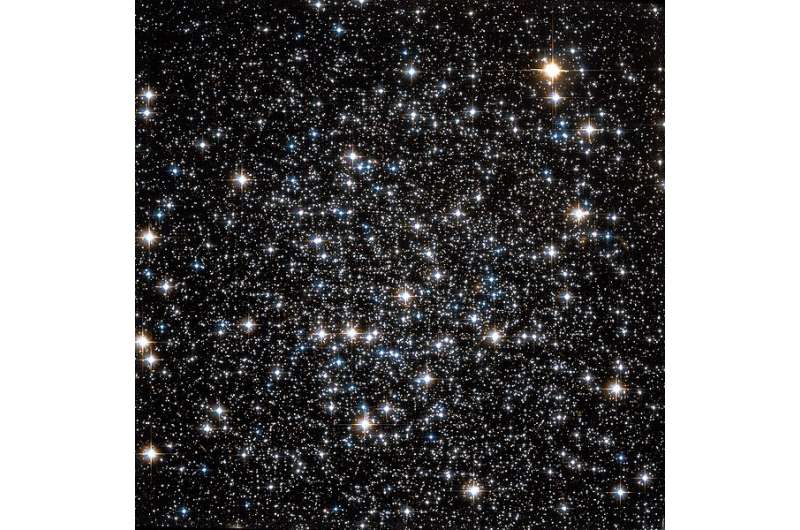September 26, 2017 report
Astronomers study the extended stellar structure around the globular cluster NGC 288

(Phys.org)—A team of astronomers led by Andrés E. Piatti of the Astronomical Observatory of Córdoba in Argentina has recently observed an extra-tidal clumpy structure around the globular cluster NGC 288. The results of these observations, available in a paper published Sept. 21 on arXiv.org, could redefine our understanding of external regions of globular clusters in our Milky Way galaxy.
NGC 288 is a globular cluster located some 28,700 light years away from the Earth in the constellation Sculptor. With an estimated age of about 10.6 billion years, this cluster belongs to low-concentration globulars, with its stars more loosely bound together. It has a large, dense core surrounded by a much more diffuse and irregular ring.
Some globular clusters in the Milky Way are surrounded by extended stellar structures. Previous observations of NGC 288 have suggested that this cluster exhibits tidal tails that could be extending up to about 1,100 light years from its center. One study reported that the cluster has two main tidal tails, one running from the cluster centre towards the southeast and another one towards the galactic center. Other research speculated on the existence of a long tidal tail from the cluster center towards the north-west beside its counterpart tail to the south-east.
Now, Piatti's team has studied the extended stellar structure around NGC 288 by analyzing the data from the Panoramic Survey Telescope and Rapid Response System (Pan-STARRS). The astrometric and photometric catalogue produced by Pan-STARRS allowed the researchers to learn more about the cluster's external region.
"We report on observational evidence of an extra-tidal clumpy structure around NGC 288 from an homogeneous coverage of a large area with the Pan-STARRS PS1 database," the astronomers wrote in the paper.
According to the paper, NGC 288 has not two or more but only a single extra-tidal clumpy structure, as commonly seen in other globular clusters in the Milky Way. This structure reaches approximately 3.5 times the cluster's tidal radius. The researchers also emphasized that NGC 288 is not a tidally limited galactic globular cluster and its main sequence stars located in the outermost regions are in some way experiencing gravitational effects due to the potential of the Milky Way.
When compared to other galactic globular clusters, NGC 288's tidal tail is a moderate extended structure. The astronomers noted that other globular clusters in the Milky Way show evidence of such features up to nearly more than six times their tidal radii.
The results of the new research, which debunked the hypothesis of several long tidal tails around NGC 288, show that external regions of galactic globular clusters should be further studied. "These results point to the need of a renewed overall study of the external regions of galactic globular clusters (GGCs) in order to reliably characterise them. Hence, it will be possible to investigate whether there is any connection between detected tidal tails, extra-tidal stellar populations, extent diffuse halo-like structures with the GGCs' dynamical histories in the galaxy," the researchers concluded.
More information: On the extended stellar structure around NGC 288, arXiv:1709.07284 [astro-ph.GA] arxiv.org/abs/1709.07284
Abstract
We report on observational evidence of an extra-tidal clumpy structure around NGC 288 from an homogeneous coverage of a large area with the Pan-STARRS PS1 database. The extra-tidal star population has been disentangled from that of the Milky Way field by using a cleaning technique that successfully reproduced the stellar density, luminosity function and colour distributions of MW field stars. We have produced the cluster stellar density radial profile and a stellar density map from independent approaches, from which we found results in excellent agreement : the feature extends up to 3.5 times the cluster tidal radius. Previous works based on shallower photometric data sets have speculated on the existence of several long tidal tails, similar to that found in Pal 5. The present outcome shows that NGC 288 could hardly have such tails, but favours the notion that interactions with the MW tidal field has been a relatively inefficient process for stripping stars off the cluster. These results point to the need of a renewed overall study of the external regions of Galactic globular clusters (GGCs) in order to reliably characterise them. Hence, it will be possible to investigate whether there is any connection between detected tidal tails, extra-tidal stellar populations, extent diffuse halo-like structures with the GGCs' dynamical histories in the Galaxy.
© 2017 Phys.org





















